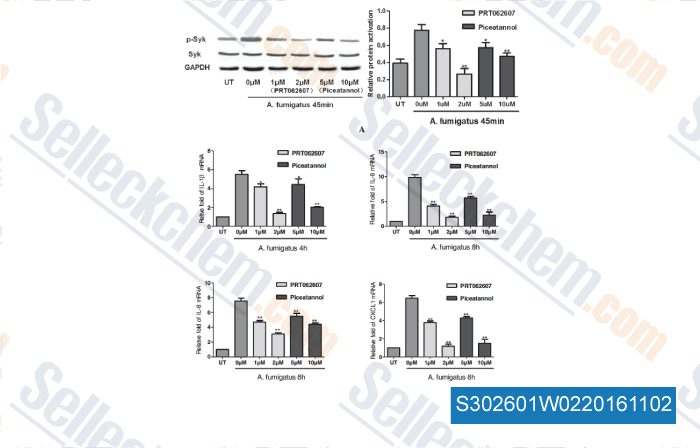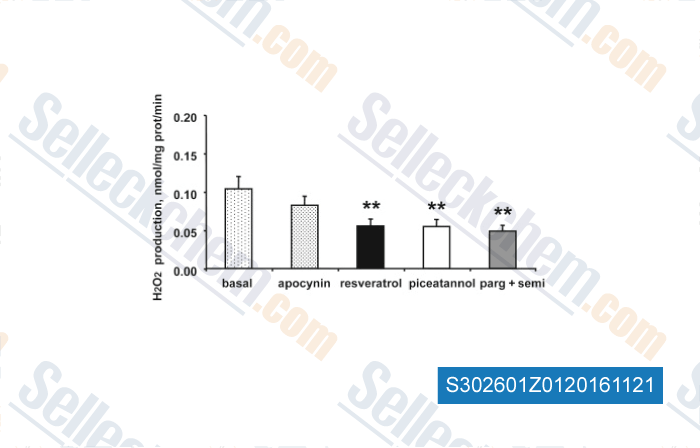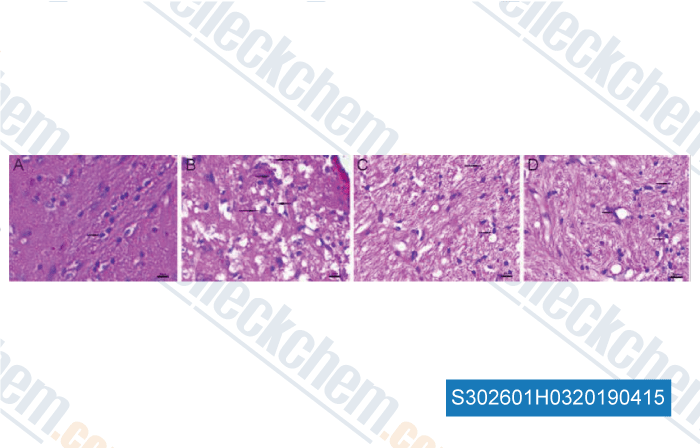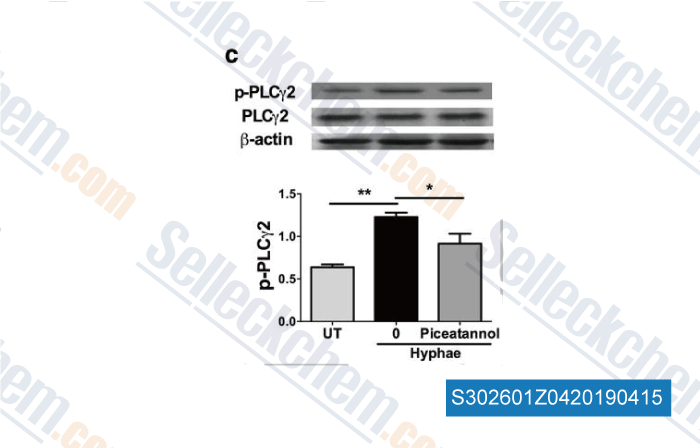|
Toll Free: (877) 796-6397 -- USA and Canada only -- |
Fax: +1-832-582-8590 Orders: +1-832-582-8158 |
Tech Support: +1-832-582-8158 Ext:3 Please provide your Order Number in the email. |
Technical Data
| Formula | C14H12O4 |
|||
| Molecular Weight | 244.24 | CAS No. | 10083-24-6 | |
| Solubility (25°C)* | In vitro | DMSO | 48 mg/mL (196.52 mM) | |
| Ethanol | 48 mg/mL (196.52 mM) | |||
| Water | Insoluble | |||
|
* <1 mg/ml means slightly soluble or insoluble. * Please note that Selleck tests the solubility of all compounds in-house, and the actual solubility may differ slightly from published values. This is normal and is due to slight batch-to-batch variations. * Room temperature shipping (Stability testing shows this product can be shipped without any cooling measures.) |
||||
Preparing Stock Solutions
Biological Activity
| Description | Piceatannol, a natural stilbene, is a selective Syk inhibitor and ~10-fold selectivity versus Lyn. | |||||||||||
|---|---|---|---|---|---|---|---|---|---|---|---|---|
| Targets |
|
|||||||||||
| In vitro | Piceatannol displays ~10-fold selectivity for Syk over Lyn. Piceatannol treatment in RBL-2H3 cells strongly inhibits the antigen-stimulated phosphorylation of Syk and of most other cellular proteins but not the receptor β or γ subunit, in a dose-dependent manner. Piceatannol is also a potent inhibitor of histamine release in mast cells. Selective inhibition of Syk by Piceatannol blocks receptor-mediated down-stream cellular responses in mast cells including prevention of 1,4,5-IP3 synthesis, secretion and membrane ruffling and spreading. [1] Piceatannol also potently inhibits PKA, PKC, MLCK, and CDPK with IC50 of 3 μM, 8 μM, 12 μM, and 19 μM, respectively. [2] Piceatannol selectively prevents the IFNα-induced tyrosine phosphorylation of STAT3 and -5 but not STAT1 and -2, paralleled by the loss of Jak1 and IFNAR1 tyrosine phosphorylation but not Tyk2 and IFNAR2. [3] Piceatannol potently induces apoptotic cell death in BJAB Burkitt-like lymphoma cells with ED50 of 25 μM, through the activation of caspase-3 and mitochondrial permeability transition independent of the CD95/Fas signaling pathway. [4] Piceatannol inhibits NF-κB activation induced by TNF, H2O2, PMA, LPS, okadaic acid, and ceramide. Piceatannol suppresses the expression of TNF-induced NF-κB-dependent reporter gene and of matrix metalloprotease-9, cyclooxygenase-2, and cyclin D1 independent of Syk kinase, by blocking TNF-induced IκBα phosphorylation, p65 phosphorylation, p65 nuclear translocation, and IκBα kinase activation. [5] Piceatannol directly binds with PI3K in an ATP-competitive manner, and suppresses PI3K activity with anti-atherosclerotic effects more effectively than resveratrol. [8] Piceatannol inhibits androgen-dependent (AD) and androgen-independent (AI) CaP cell proliferation, which is accompanied by reduced expression of mTOR and its key effectors AKT and eIF4EBP-1. [10] | |||||||||||
| In vivo | Oral administration of Piceatannol induces a remarkable amelioration of the disruption of the colonic architecture, a significant reduction in colonic myeloperoxidase (MPO) activity, and a decrease in production of inflammatory mediators such as nitric oxide (NO), prostaglandin (PG) E2, and pro-inflammatory cytokines in BALB/c mice with dextran sulfate sodium (DSS)-induced colitis. [7] Piceatannol treatment inhibits the rises in blood glucose levels at early stages and improves the impaired glucose tolerance at late stages in type 2 diabetic model db/db mice. [9] |
Protocol (from reference)
| Kinase Assay: |
|
|---|---|
| Cell Assay: |
|
| Animal Study: |
|
References
Customer Product Validation

-
, , BMC Ophthalmol, 2014, 15:56.

-
Data from [Data independently produced by , , Chem Biol Interact, 2016, 258:115-25. ]

-
Data from [Data independently produced by , , Neural Regen Res, 2018, 13(8):1425-1432]

-
Data from [Data independently produced by , , BMC Ophthalmol, 2018, 18(1):170]
Selleck's Piceatannol has been cited by 37 publications
| Polyaniline-Based Glyco-Condensation on Au Nanoparticles Enhances Immunotherapy in Lung Cancer [ ACS Appl Mater Interfaces, 2022, 14(21):24144-24159] | PubMed: 35579575 |
| Piceatannol enhances Beclin-1 activity to suppress tumor progression and its combination therapy strategy with everolimus in gastric cancer [ Sci China Life Sci, 2022, 10.1007/s11427-022-2185-9] | PubMed: 36271983 |
| Global post-translational modification profiling of HIV-1-infected cells reveals mechanisms of host cellular pathway remodeling [ Cell Rep, 2022, 38(13):110567] | PubMed: 35354044 |
| Main Determinants Affecting the Antiproliferative Activity of Stilbenes and Their Gut Microbiota Metabolites in Colon Cancer Cells: A Structure-Activity Relationship Study [ Int J Mol Sci, 2022, 23(23)15102] | PubMed: 36499424 |
| Orientia tsutsugamushi Infection Stimulates Syk-Dependent Responses and Innate Cytosolic Defenses in Macrophages [ Pathogens, 2022, 12(1)53] | PubMed: 36678402 |
| Orientia tsutsugamushi Infection Stimulates Syk-Dependent Responses and Innate Cytosolic Defenses in Macrophages [ Pathogens, 2022, 12(1)53] | PubMed: 36678402 |
| CCL4-mediated targeting of spleen tyrosine kinase (Syk) inhibitor using nanoparticles alleviates inflammatory bowel disease [ Clin Transl Med, 2021, 11(2):e339] | PubMed: 33634985 |
| TREM1 Regulates Neuroinflammatory Injury by Modulate Proinflammatory Subtype Transition of Microglia and Formation of Neutrophil Extracellular Traps via Interaction With SYK in Experimental Subarachnoid Hemorrhage [ Front Immunol, 2021, 12:766178] | PubMed: 34721438 |
| Inhibition of Dectin-1 Ameliorates Neuroinflammation by Regulating Microglia/Macrophage Phenotype After Intracerebral Hemorrhage in Mice [ Transl Stroke Res, 2021, 10.1007/s12975-021-00889-2] | PubMed: 33539006 |
| Polyphenols and Cannabidiol Modulate Transcriptional Regulation of Th1/Th2 Inflammatory Genes Related to Canine Atopic Dermatitis [ Front Vet Sci, 2021, 8:606197] | PubMed: 33763461 |
RETURN POLICY
Selleck Chemical’s Unconditional Return Policy ensures a smooth online shopping experience for our customers. If you are in any way unsatisfied with your purchase, you may return any item(s) within 7 days of receiving it. In the event of product quality issues, either protocol related or product related problems, you may return any item(s) within 365 days from the original purchase date. Please follow the instructions below when returning products.
SHIPPING AND STORAGE
Selleck products are transported at room temperature. If you receive the product at room temperature, please rest assured, the Selleck Quality Inspection Department has conducted experiments to verify that the normal temperature placement of one month will not affect the biological activity of powder products. After collecting, please store the product according to the requirements described in the datasheet. Most Selleck products are stable under the recommended conditions.
NOT FOR HUMAN, VETERINARY DIAGNOSTIC OR THERAPEUTIC USE.
